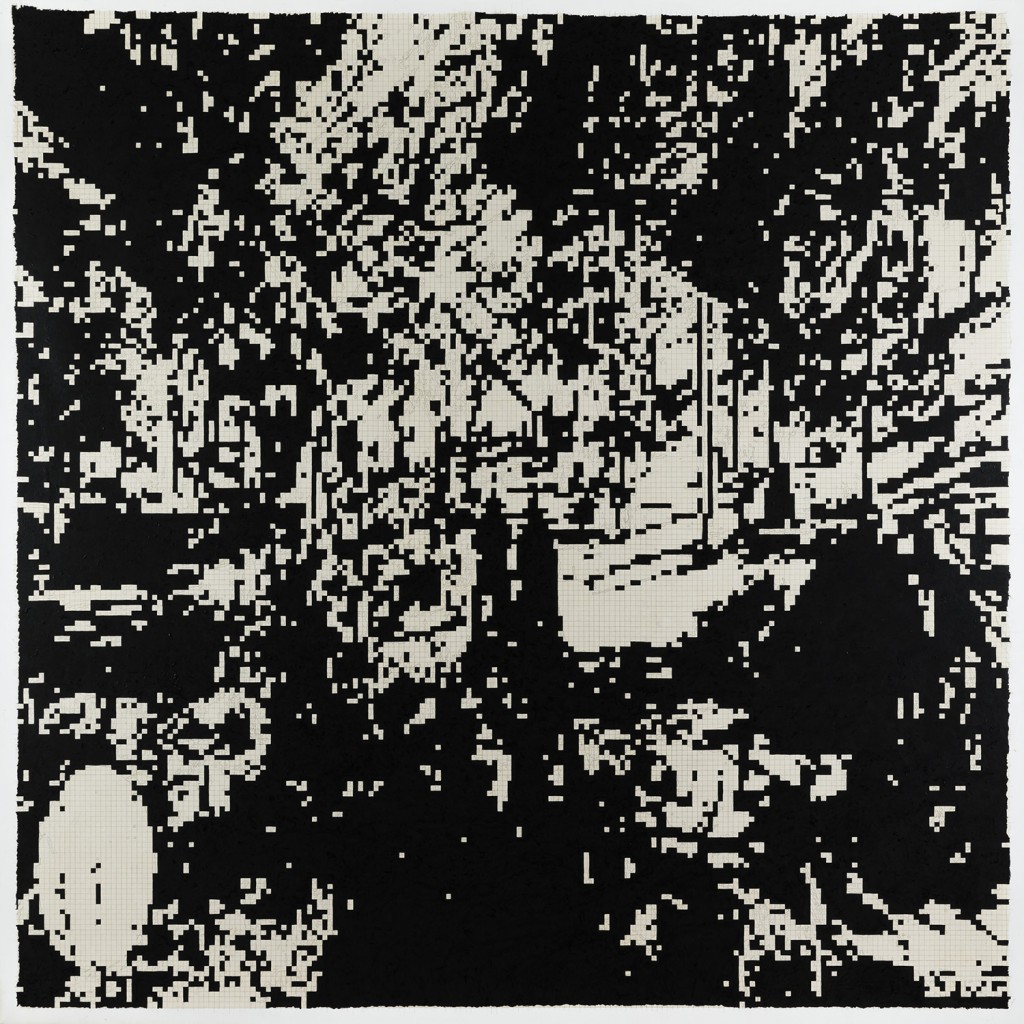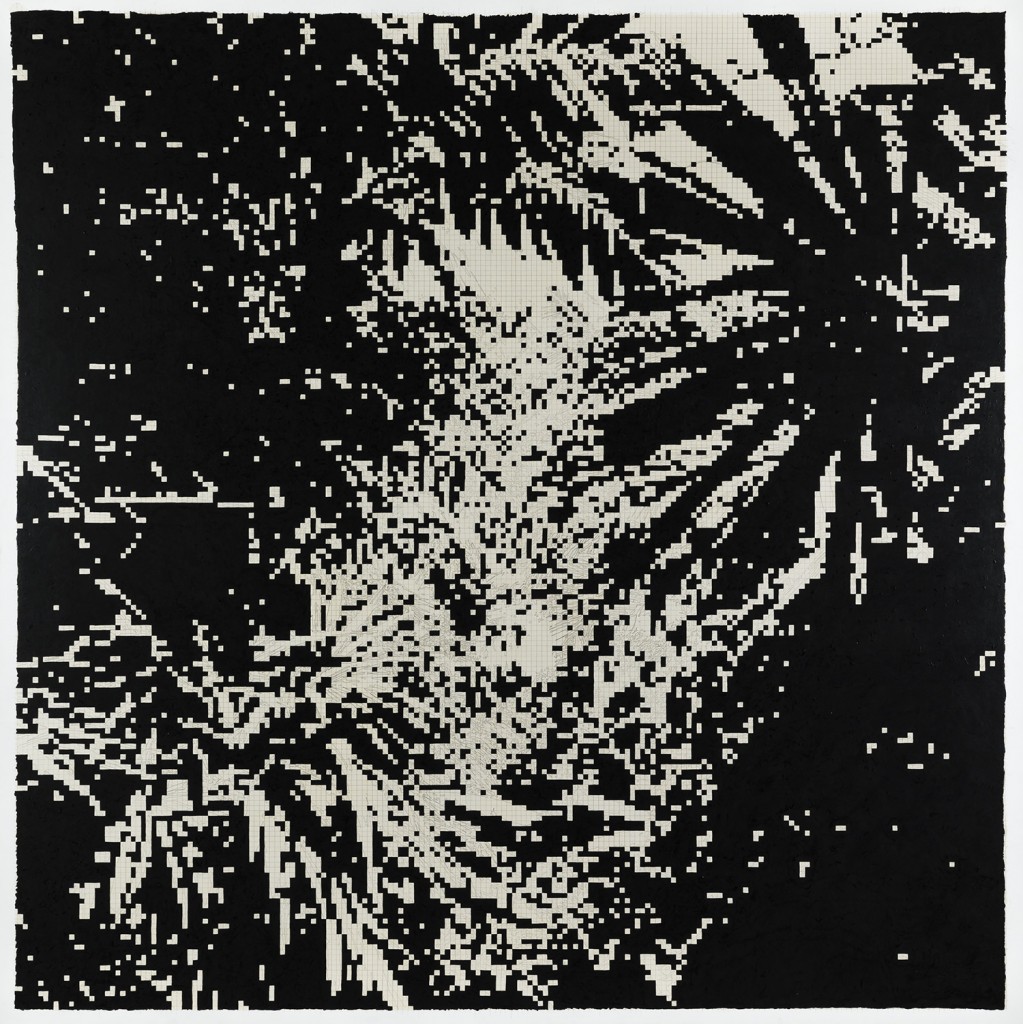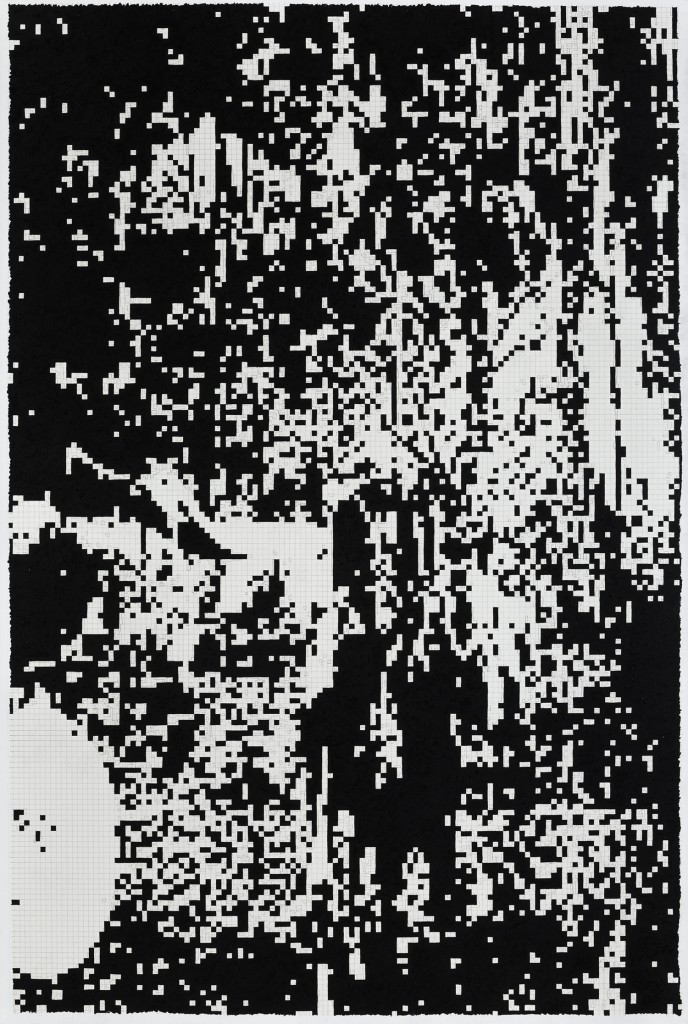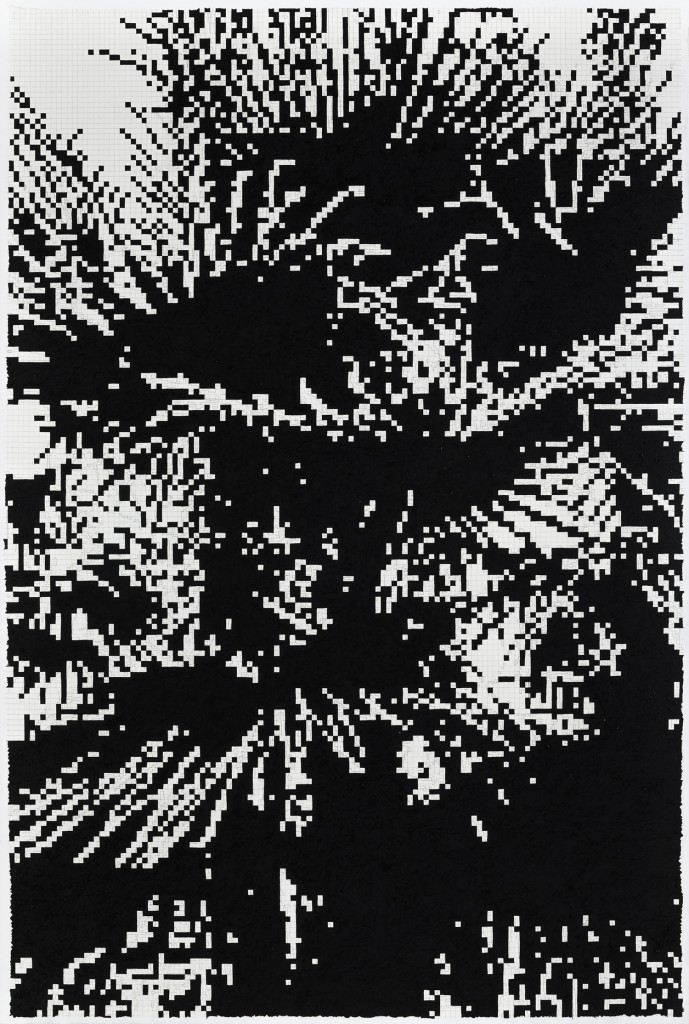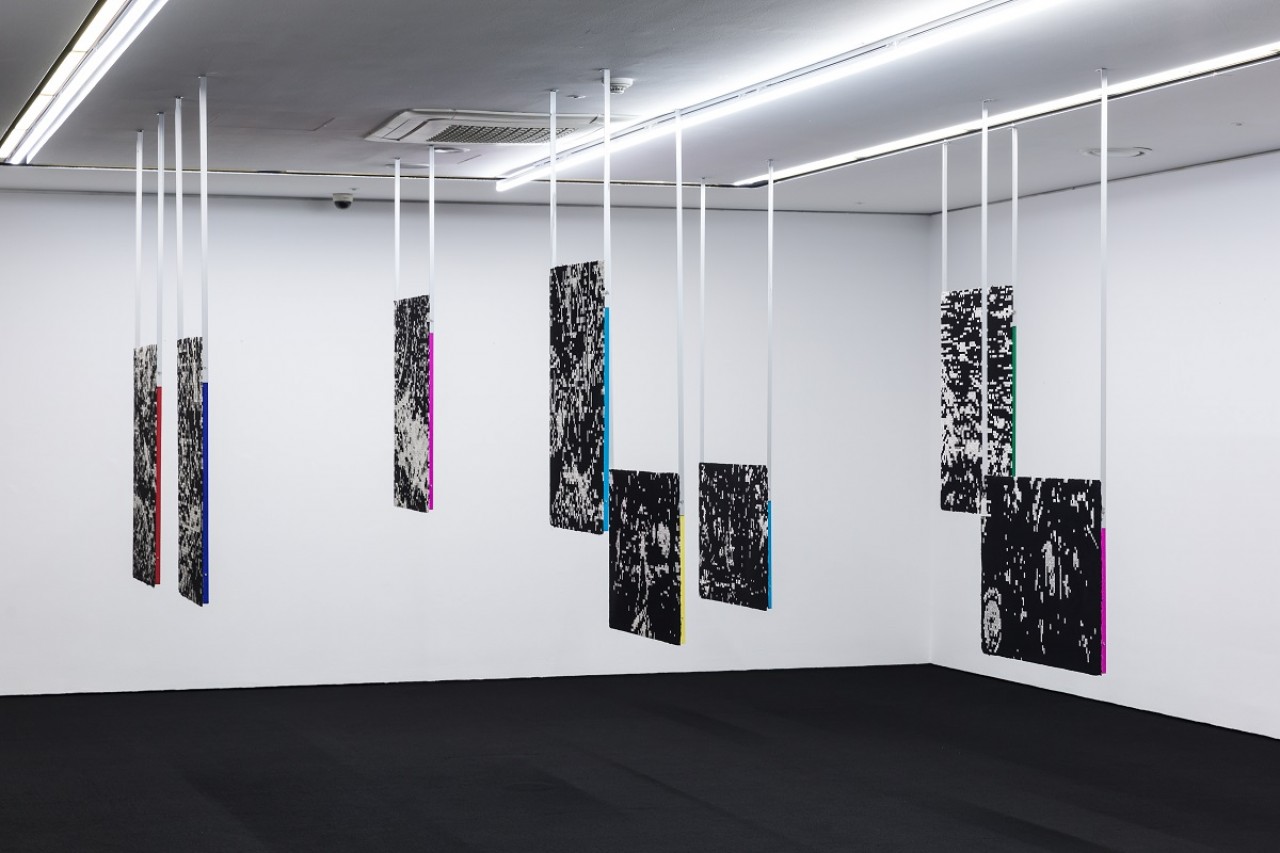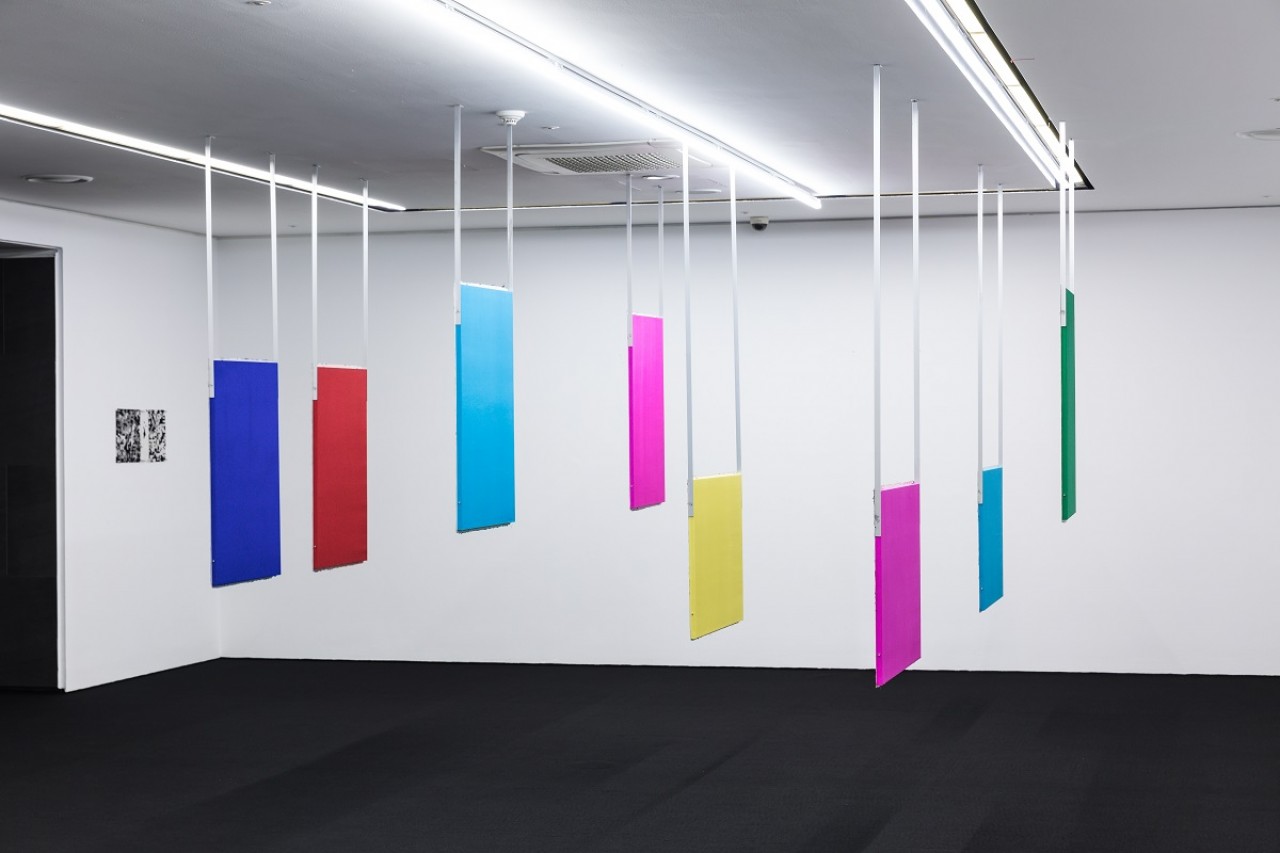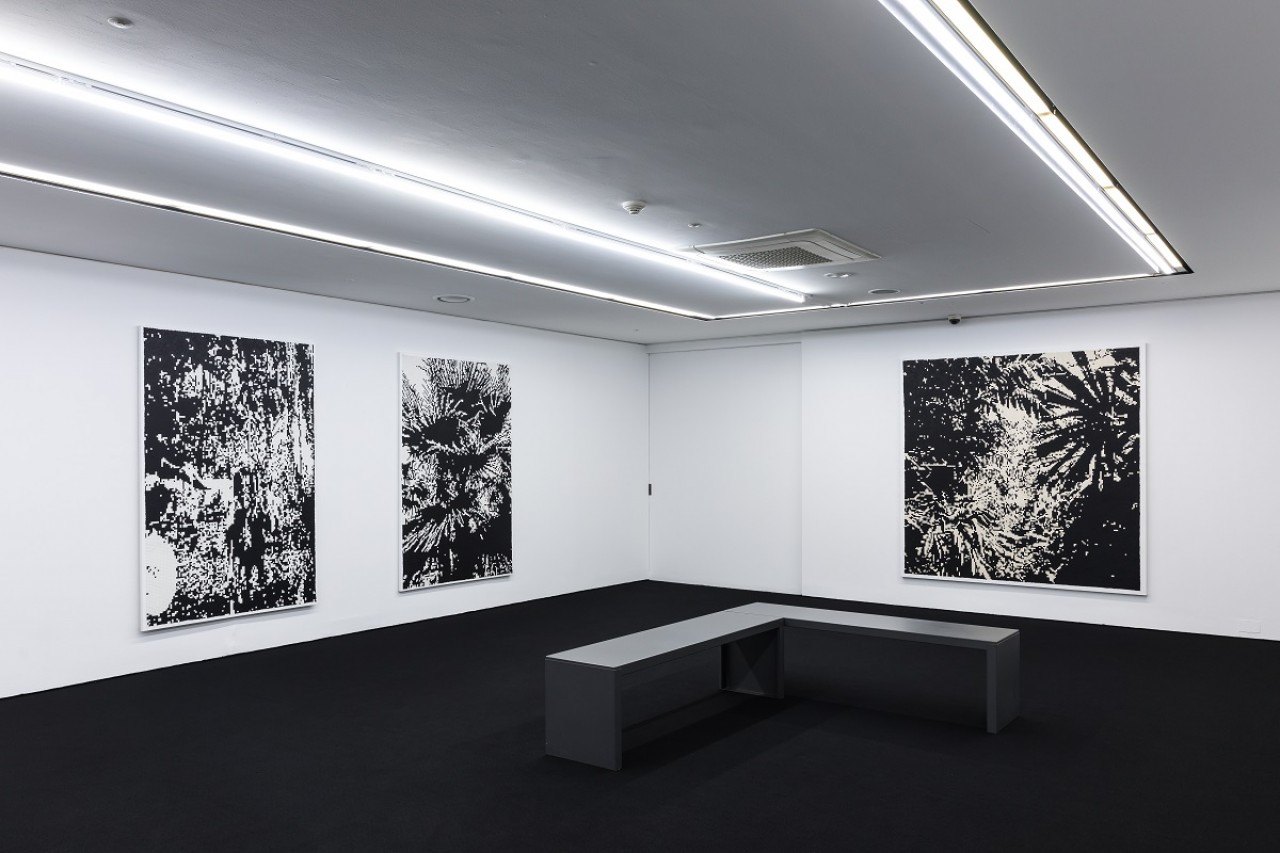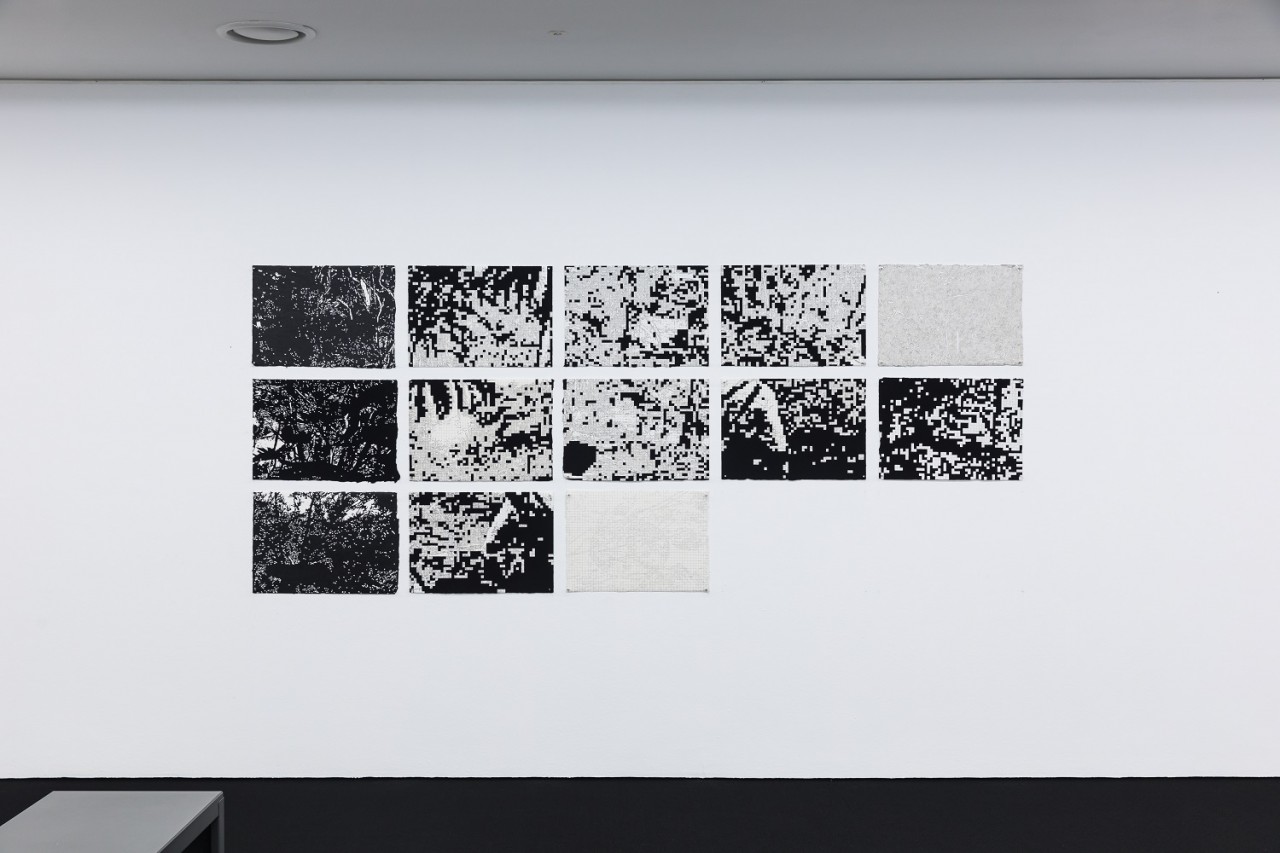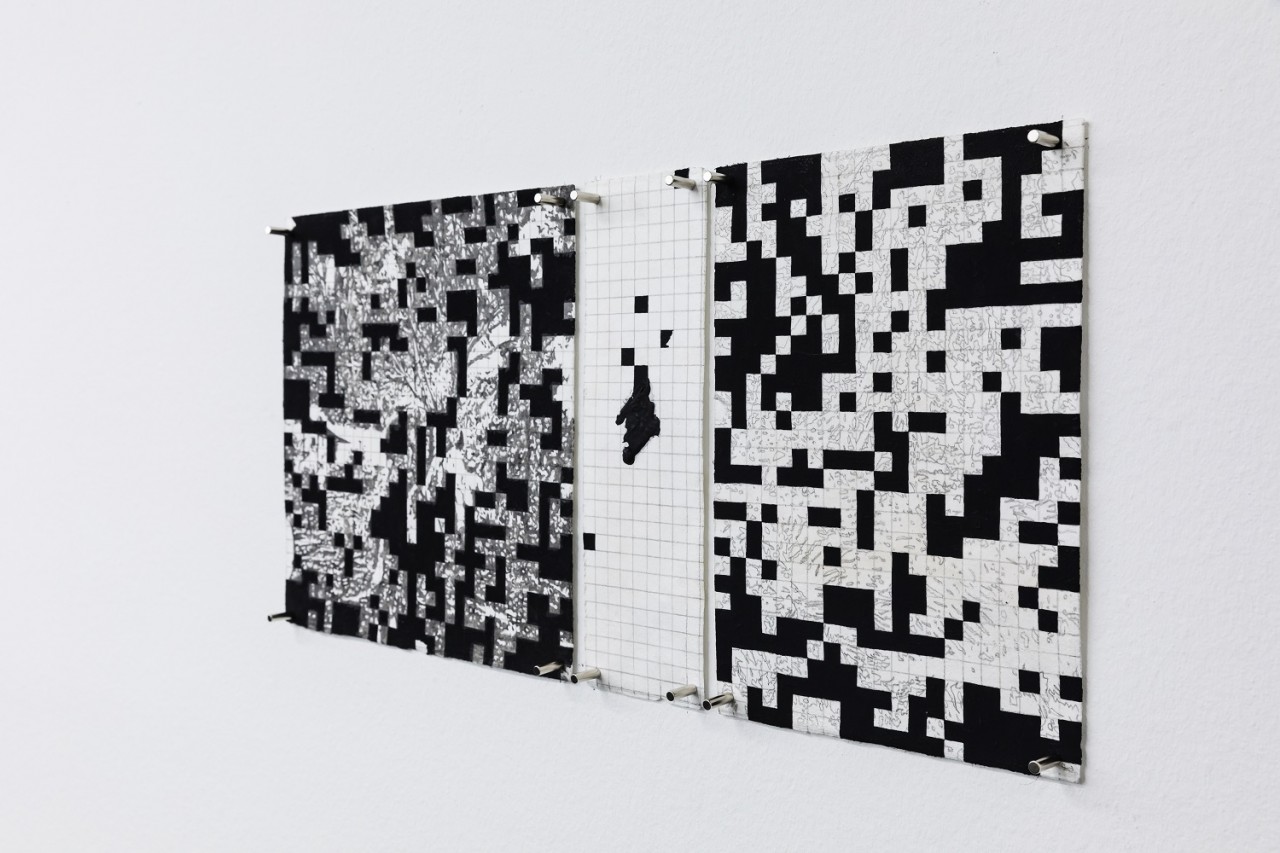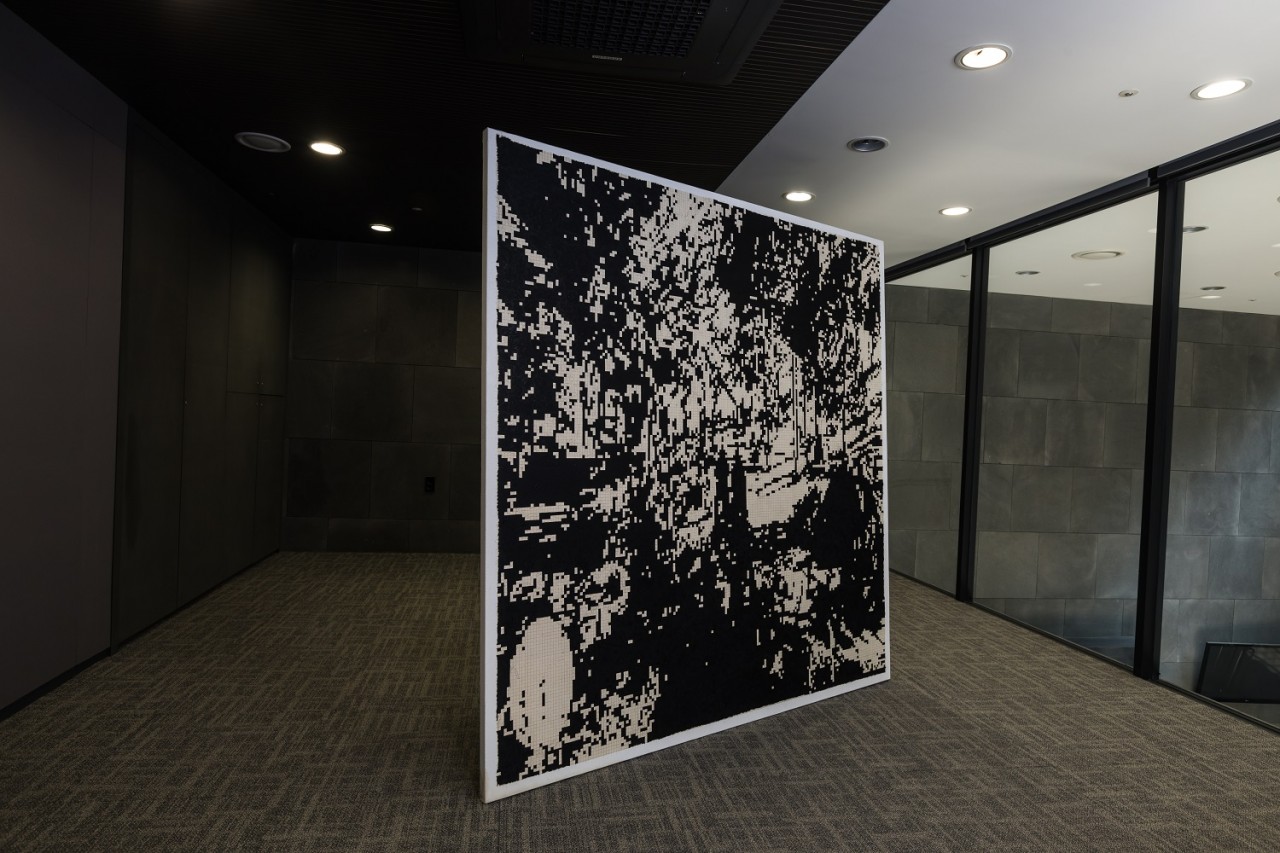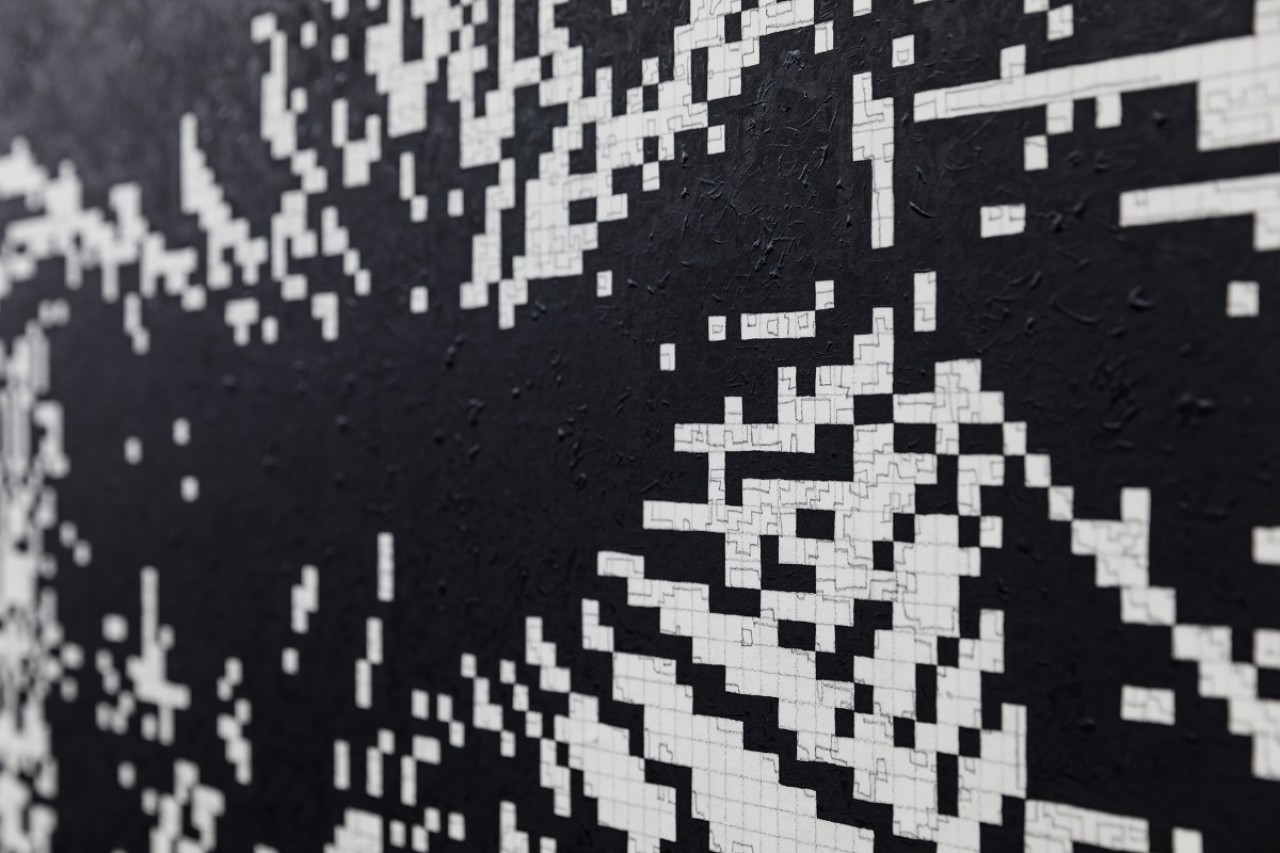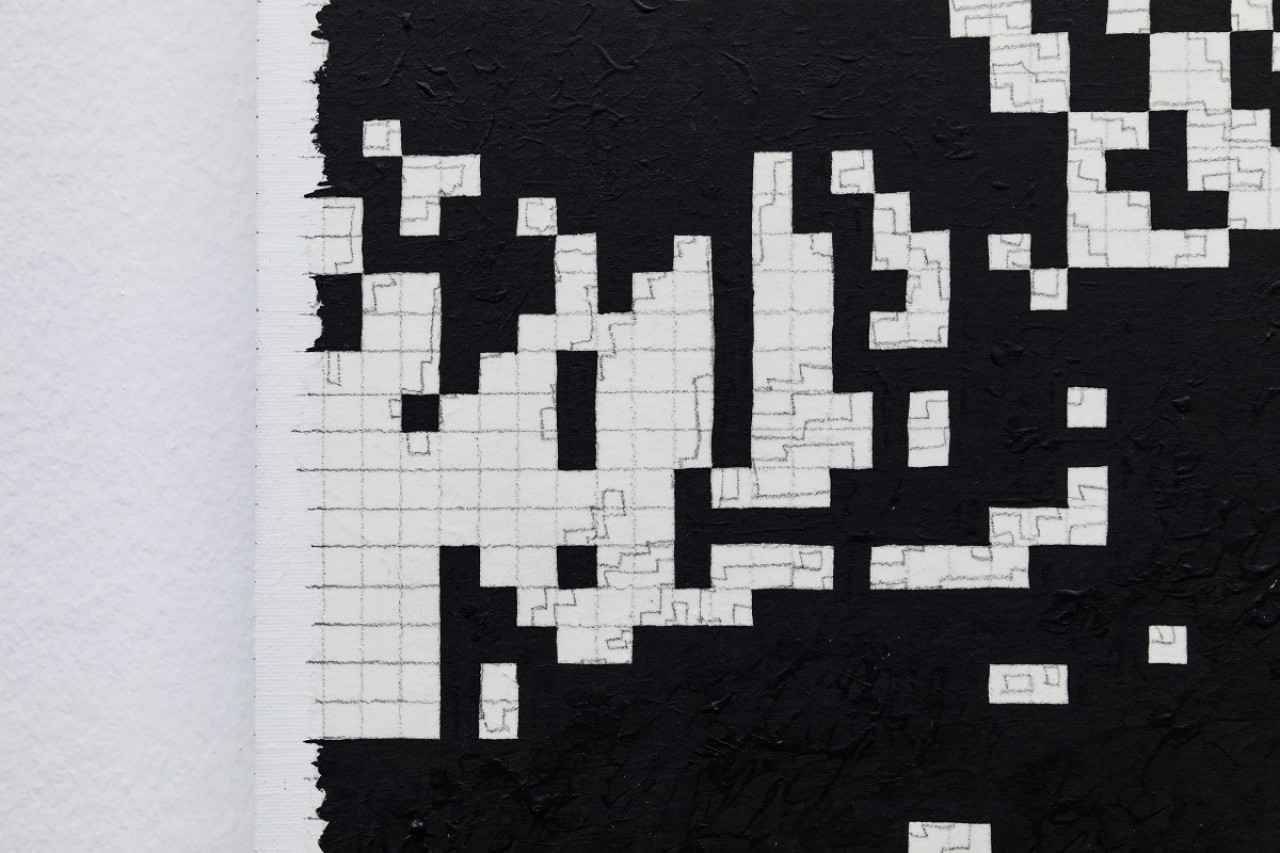Exhibitions
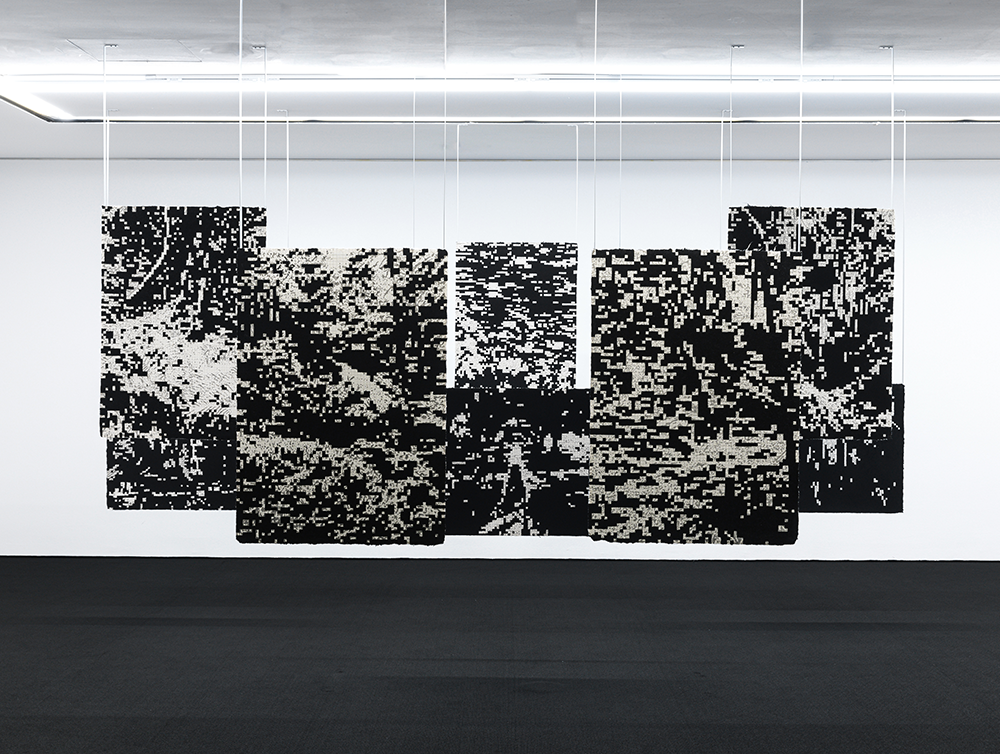
PERIGEE ARTIST #28 장재록
The Square
2022.06.03. FRI ~
2022.07.30. SAT
<채우고 비운 풍경>
신승오 (페리지갤러리 디렉터)
장재록은 화면에 격자 틀을 기본으로 그려 놓고 그 네모난 한 칸을 하나씩 검은 먹으로 채우거나 비워 놓는 방식으로 그려 나간다. 그가 주된 그림의 대상으로 사용하는 소재는 자연의 풍경과 게임의 배경으로 만들어지는 디지털화된 인위적 풍경이다. 이러한 소재는 바로 그림으로 옮겨지는 것이 아니라 작가가 만들어 놓은 임의의 규칙에 따라 변형의 과정을 거친다. 먼저 그가 선택한 이미지는 컴퓨터 화면상에서 흑백의 이미지로 변환된다. 이렇게 수정된 이미지는 두 단계를 거쳐 실제 화면으로 옮기게 되는데, 우선 그리드의 칸은 고려하지 않고 옅은 회색으로 이미지의 외곽선을 따라 그 대상의 형태를 중묵(中墨)을 사용하여 그려낸다. 이것은 밑그림의 역할을 하는데 예를 들어 그리드 한 칸을 차지하는 스케치의 비중이 크면 완전히 농묵(濃墨)을 사용하여 검은색으로 칠하고 여백이 좀 더 많아 보이면 비워 놓는다. 이는 마치 0과 1로 이루어지는 이진법을 기계적으로 적용하여 그리고 있는 것처럼 보인다. 일견 복잡해 보이는 이러한 변환의 과정은 그의 작업에 중요한 방법론이며, 작가가 선택한 이 방식의 이유와 의미를 발견하는 것이 이번 전시를 이해하는 척도가 된다.
《The Square》는 말 그대로 사각형을 지칭하며, 작가가 만들어내는 그리드에서 가장 작은 단위인 사각형 모양의 픽셀을 의미한다. 이러한 그리드로 이루어진 사각형은 하나....
The Scene Filled and Emptied
Seung Oh Shin (Director of Perigee Gallery)
JANG Jaerok works by basically drawing a lattice and then fills or empties each square one by one. The subject matter he has primarily adopted for his pictures is natural scenery or a digitalized artificial scene made for a computer game’s background. This subject matter is not immediately transferred to a picture but goes through a process of transformation depending on an arbitrary rule JANG has stipulated. The image he chose turns into a black-and-white image on a computer screen. This modified image is transferred to paper attached to the canvas after going through two phases. The form of an object is drawn in pale gray ink along its outline with no thought of grids. This rendition works as a sketch. An example is that thick ink coloring is employed if the sketch takes up a greater part of one square and the square remains empty if there are wider blank spaces. This seems to illustrate images by mechanically applying a binary system made up of 0s and 1s. The process of this seemingly intricate conversion is a methodology of great signi....
신승오 (페리지갤러리 디렉터)
장재록은 화면에 격자 틀을 기본으로 그려 놓고 그 네모난 한 칸을 하나씩 검은 먹으로 채우거나 비워 놓는 방식으로 그려 나간다. 그가 주된 그림의 대상으로 사용하는 소재는 자연의 풍경과 게임의 배경으로 만들어지는 디지털화된 인위적 풍경이다. 이러한 소재는 바로 그림으로 옮겨지는 것이 아니라 작가가 만들어 놓은 임의의 규칙에 따라 변형의 과정을 거친다. 먼저 그가 선택한 이미지는 컴퓨터 화면상에서 흑백의 이미지로 변환된다. 이렇게 수정된 이미지는 두 단계를 거쳐 실제 화면으로 옮기게 되는데, 우선 그리드의 칸은 고려하지 않고 옅은 회색으로 이미지의 외곽선을 따라 그 대상의 형태를 중묵(中墨)을 사용하여 그려낸다. 이것은 밑그림의 역할을 하는데 예를 들어 그리드 한 칸을 차지하는 스케치의 비중이 크면 완전히 농묵(濃墨)을 사용하여 검은색으로 칠하고 여백이 좀 더 많아 보이면 비워 놓는다. 이는 마치 0과 1로 이루어지는 이진법을 기계적으로 적용하여 그리고 있는 것처럼 보인다. 일견 복잡해 보이는 이러한 변환의 과정은 그의 작업에 중요한 방법론이며, 작가가 선택한 이 방식의 이유와 의미를 발견하는 것이 이번 전시를 이해하는 척도가 된다.
《The Square》는 말 그대로 사각형을 지칭하며, 작가가 만들어내는 그리드에서 가장 작은 단위인 사각형 모양의 픽셀을 의미한다. 이러한 그리드로 이루어진 사각형은 하나의 규칙이 적용되는 틀로써 엄격하게 독립된 개별 공간으로 사용된다. 그가 이 같은 요소를 선택한 이유는 개인적으로는 가장 자신에게 명확한 경계를 가진 틀로서 안정감을 주기 때문이다. 두 번째 이유는 실제와 가상을 넘나드는 우리가 현재 사는 시공간에서 겪는 시각적 경험을 고스란히 자신의 회화적 평면에 담아내기 위함이다. 그가 말하는 시공간은 구조적으로 온라인과 오프라인 다시 말해 실재하는 것과 가상의 것을 모두 포함하고 있으며, 이는 하나의 차원에 계속해서 머물지 않는다. 그렇다면 그에게 시각적 경험은 외부의 구체적인 대상을 인식하는 것에서 시작하여 우리의 내부에서 추상적인 감각들로 전환되고 이를 기존의 경험과 연결하는 일련의 과정이다. 이런 경험은 어떤 특별한 경계를 가지고 전환되기보다는 즉각적이고 무의식적으로 일어난다. 그러나 작가는 자신이 시각적 환경에서 느끼는 경험으로 나타나는 감정이나 생각들을 단순히 재현하려 하지 않는다. 이를 위해서 그가 고안한 것이 그리드를 사용하여 자신의 직관적이고 자유로운 표현을 통제하는 것이다. 그가 만든 그리드의 기본단위인 사각형 안에서 붓질은 자신이 임의로 만든 규칙에 의해 제한적인 움직임만 가능하게 된다. 이렇게 작가는 자기 자신에게 기계적 판단을 덧씌워 자신의 무의식적인 행위를 통제하는 방식으로 디지털 이미지가 구현하는 감각을 자신의 작업에 적용하고자 한다. 따라서 최종 결과물인 사각형을 검은색으로 채우는 과정을 통해 나타나는 회화의 표면은 그것의 소재가 무엇인지 상관없이 표면상으로 유사하다.
이렇듯 작가에 의해 변형되는 자연과 디지털 환경이 보여주는 풍경은 서로를 투영하고 있는 거울과 같다. 그도 그럴 것이 우리는 자연의 이미지를 점점 디지털 이미지처럼 생생하다고 생각하고 게임의 인위적 자연 이미지는 점점 실제의 모습을 닮아가고 있다. 이렇게 이 둘 사이의 거리는 점점 좁혀져 가고 있으며, 단순히 가상이 실제를 모방하는 일방적인 상황이 아니라 가상의 것이 실재하는 것에 영향을 끼치는 상호 연결 고리들을 통해 또 다른 리얼리티가 형성되어 가고 있다. 작가는 이러한 리얼리티를 그림으로 표현하기 위해서 회화의 기본적인 특성인 평면성에 주목한다. 그리고 그의 작업에서 그리드는 가장 기본적인 틀로서 경계를 명확하게 가지고 있지만 이와 동시에 자유로운 공간으로 설정된다. 또한 개별의 사각형 공간은 전체로 보면 큰 사각형 공간이기도 하다. 이렇게 그리드의 사각형은 그 자체로 평면성을 드러낼 수도 있고, 사각형을 사선으로 연결해 원근법을 적용해서 환영적 공간이 될 수도 있을 것이다. 그는 이러한 다양한 가능성을 하나의 화면에서 동시에 실험해보고 있는데, 이는 원본에서 변환된 흑백의 이미지를 바로 그리드에 적용하지 않고 다시 밑그림을 그리는 순서에 있다. 여기서 밑그림은 대상을 정확하게 묘사하지 않고 흑백으로 전환한 이미지의 검은 형태를 따라 그 흔적을 남겨놓는다. 이렇게 모호한 형태만 남은 대상은 완전히 원래의 배경과 분리되어 버린다. 그리고 그 자체로 새롭게 그려진 현실이지만 최종 단계에서는 검은색으로 칠하는 판단의 기준에 지나지 않게 된다. 작가가 만들어 놓은 그리드, 밑그림, 검은 사각형 픽셀의 세 단계로 이루어진 층위는 단순히 변환을 위한 행위로 이루어진다. 이런 단계로 진행되는 최소 단위인 사각형의 경계를 고려하지 않는 스케치와 그 사각형의 경계를 넘지 못하는 검은색의 구속, 이에 따라 나타나는 서로 다른 붓질 그리고 전혀 아무런 행위도 하지 않은 요소들이 서로 교차한다. 그리고 그 결과로 나타나는 검은 표면에서는 개별 사각형의 경계조차도 사라져 버린다. 여기에 더해 검게 채워진 것들을 연결해 보면 무엇인가 구체적인 대상처럼 보이는 이미지를 통해 원본의 대상을 유추할 수 있으나 명확하지는 않다. 여기서 흥미로운 지점은 아무것도 칠해지지 않은 빈 사각형이다. 이는 여전히 경계를 명확하게 가진 미완의 모습으로 보이지만 이 또한 빈 곳만 연결해 보면 어떤 형상으로 보이기도 한다. 그의 작업에서 빈 곳은 단순한 여백이 아니라 또 다른 이미지이면서 기존의 검은색으로 채워진 것과 서로 반전되어 인식할 수 있는 새로운 경계의 역할을 하고 있다.
이러한 그의 작업은 자신이 경험하는 다층적인 시공간이 만들어내는 감각을 회화적 평면에 담기 위한 시도를 잘 보여준다. 이렇게 구성된 그리드 외에 작가가 사용하는 색에서도 그 생각을 살펴볼 수 있다. 그가 사용하는 검은 색은 먹을 사용한 농묵(濃墨)이고 밑그림은 중묵(中墨)을 사용하여 회색 조로 표현된다. 이는 흑과 빈 곳의 색으로 인한 분리를 자연스럽게 연결하고 있다. 다시 말해 이러한 농담을 통한 색의 조절은 개별의 사각형이 연결되어 서로에게 끊임없이 침투하거나 분리되는 효과를 준다. 또한 통제된 붓질로 인하여 즉물적인 형식으로 보이지만 먹이 가진 농담의 표현으로 인하여 새로운 질감이 드러나기도 한다. 그렇지만 이번에 전시된 작품의 뒷면이 빛의 삼원색인 빨강 녹색 파랑과 그 혼합의 색으로 이루어져 있는 것으로 미루어보면, 그가 사용하는 검은색은 오히려 다채로운 색을 단순화하고 압축하여 응축된 형태를 의도한 것으로 보인다. 이는 가상과 실재가 명확하게 분절된 것이 아니라 이미 서로에게 스며들어 단단히 연결된 총체적인 세상으로 변했음을 보여주고자 함이다. 따라서 그가 작업을 통해 보여주는 자연과 게임의 풍경은 색이나 형태를 통해 시각적으로 구분되지 않는다. 이렇게 그의 사각형 픽셀은 여전히 평면적이고 암묵적인 동시에 명시적인 효과를 보여준다.
작가는 실체를 가진 물질적인 자연이든 비물질적인 디지털 이미지이든 자신이 그것들을 인식하여 회화로 옮기는 데에 있어서 적당한 거리를 유지하고 있다. 이는 지금까지 살펴본 바와 같이 어떤 대상에 작가의 감정을 투영하기보다는 객관적인 태도로 바라보며 이를 통해 새로운 회화의 평면성을 실험하기 위한 것이다. 하지만 여기에는 사실상 작가의 의도와는 상관없는 오류들이 나타난다. 우선 하나의 사각형에 완벽하고 깔끔하게 색을 칠하기는 어렵다. 그리고 붓에 가해지는 힘도 계속해서 동일하지 않기 때문에 사각형의 경계를 번져나가기 쉬우며, 같은 검은색도 농담이 달라 표면의 질감에 의해 동일한 색으로 보이지만 가까이에서 보면 서로 다르다. 여기에 더해 검은색이 연이어 나타날 때는 사각형의 그리드는 완전히 사라져 그 경계를 알 수 없다. 하지만 그 개별의 대상을 소멸시켜 통일성 있는 하나의 풍경을 만들기보다는 각각의 픽셀에 독립성을 부여하고 이들의 연결과 단절을 이어 나가는 관객의 시선에 의해 또 다른 회화만의 풍경으로 만들고자 하는 의도가 눈에 띈다. 그렇다고 해서 그가 표현하고자 하는 것은 막연히 유동적이거나 끊임없이 흘러내리는 일시적으로 발생하는 사건으로서의 수직적 움직임을 강조하는 감각은 아니다. 오히려 그가 이번에 선보이는 회화는 서로 내용상으로 구분되지 않는 실재와 가상이 수평적으로 연결된 작가에 의해 만들어진 새로운 리얼리티의 풍경이다.
지금까지 살펴본 것과 같이 장재록은 회화의 평면성을 중요시한다. 이는 평면적인 회화가 가진 표면과 내면, 실제와 가상, 구상과 추상, 재현과 실재의 사이에서 작가가 자신을 어디에 위치시키는가에 따라 달라지는 회화의 본질을 재사유하고자 하는 것이다. 그렇기에 이번 작품 연작의 제목인 《Another Act》의 ‘또 다른 행위’라는 것은 자신이 바라보는 대상과 작가의 내면이 연결되는 지점을 회화의 표면으로 옮기면서 인식의 주체를 드러내기 위한 것이 아니라 주체와 대상이 수평적인 균형을 잡으면서 회화의 평면에서 서로에게 스며들게 만들기 위한 행위이다. 따라서 그가 어떤 규칙에 의해 무엇인가를 그림으로 옮기는 행위는 작가가 의도하는 것과 의도하지 않는 것에 의해 만들어지는 시공간을 교차시킨다. 이에 따라 결과적으로 우리가 보는 사각형으로 구성된 풍경은 본질적으로 특별한 경험을 유발하고 차이를 발생시키는 다양한 시공간을 수평적으로 연결한다. 결국 그가 계속해서 다다르고자 하는 회화는 이성과 감성, 재현과 즉물, 지시성과 물질성이 공존하는 입체적이면서도 지극히 평면적인 시공간이다. 이렇게 그의 회화에서 ‘또 다른 행위’는 하나의 영역을 다른 영역으로 옮기고 다시 이를 겹쳐 놓으며 다층의 시공간에서 발생하는 시각적 표면의 의미들을 그려내는 것이다. 그리고 이 풍경은 사각형의 픽셀이 서로 닮아가고, 끌어당기고, 밀어내면서 하나의 장면으로 구현되는 자신만의 회화적 리얼리티를 구성하고 있다.
Seung Oh Shin (Director of Perigee Gallery)
JANG Jaerok works by basically drawing a lattice and then fills or empties each square one by one. The subject matter he has primarily adopted for his pictures is natural scenery or a digitalized artificial scene made for a computer game’s background. This subject matter is not immediately transferred to a picture but goes through a process of transformation depending on an arbitrary rule JANG has stipulated. The image he chose turns into a black-and-white image on a computer screen. This modified image is transferred to paper attached to the canvas after going through two phases. The form of an object is drawn in pale gray ink along its outline with no thought of grids. This rendition works as a sketch. An example is that thick ink coloring is employed if the sketch takes up a greater part of one square and the square remains empty if there are wider blank spaces. This seems to illustrate images by mechanically applying a binary system made up of 0s and 1s. The process of this seemingly intricate conversion is a methodology of great significance, and to discover why he adopts this method and its meaning is a measure of figuring out this exhibition.
The Square referring literally to a square means a regular quadrilateral-shaped pixel, the smallest unit of the grids JANG makes. This square in a grid is used as an independent individual space and as a frame applied with one single rule. JANG has chosen this factor, firstly, because it gives us a sense of stability. Secondly, he intends to represent our visual experience in space-time in his own two-dimensional pictorial surface. This space-time structurally covers both online and offline, i.e. the real and imaginary, not continuously staying in one dimension. To him, any visual experience is a series of processes that starts from perceiving an external, concrete object, converts into our internal abstract sense, and relates to our preexisting experience. This experience immediately and unconsciously recurs rather than converting based on some specific boundary. The artist, however, would not simply represent an emotion or thought that is an outgrowth of his own experience in some visual environment. What he has conceived for this is to control his intuitive, unrestricted expression using a grid. His brushstrokes restrictively move in squares, the basic unit of a grid, relaying the rule he set arbitrarily. JANG intends to apply the sense embodied by digital images to his work by regulating his own unconsciousness and lending mechanical judgment to himself.
The nature modified by the artist and the scene shown as a digital environment are like mirrors reflecting each other. This is because we tend to think that any natural image is as vivid as a digital image, and artificial images of nature in games look more and more real. The distance between the two has gradually become closer. And another reality is formed through a mutual link in which the real is influenced by the imaginary, not through the unilateral situation in which the imaginary simply imitates the real. JANG takes note of flatness to represent this reality in paintings. The grid in his work has a fundamental frame, but this is set as an unconstrained space at the same time. Each quadrilateral space also creates a large square space if seen as a whole. A square in a grid is able to reveal flatness as it is, and furthermore can create an illusory space by connecting many quadrilaterals diagonally and applying perspective. He experiments with such diverse possibilities in one scene at the same time. Black-and-white images altered from the original are not immediately applied to the grid, but a sketch is drawn again. The sketch here is not an accurate portrayal of an object, but leaves traces following a black form transformed into a black-and-white image. The vague object is entirely separate from its original background. And this sketch itself is drawn newly, but it is nothing but a template for judgment to paint black during the final stage of painting. The layers made up of a grid, sketch, and black square pixels are created by actions for conversion. The sketch is unconcerned with the borders of squares, and completely non-acting elements intercross. And, even borders of each black square disappear in its resultant black surface. We can infer the original object out of some concrete object-like images if we connect images of black ink to one another. Intriguing here is the empty squares to which nothing is applied. Each empty space in his work is not merely a blank space but another image, assuming the role of a new boundary in which we can perceive objects.
His work is an eloquent representation of his attempt to put the sense engendered by multi-dimensional space-time he experienced into his pictorial flat surface. His ideas can be gauged not only from his grids, but also from his colors. He adopts thick black ink while his sketches are drawn in gray using a middle-tone ink color. This helps to naturally remove any separation brought on by black and other colors. That is, adjustment of colors through this light and shade gives rise to effects when each square is fused, infiltrating into and separated from one another. This rendition seems to be realistic and practical due to regulated brushwork, a new texture is revealed by the expression of ink’s light and shade. Judging from the fact that the backs of works on show at this exhibition consist of the three primary colors of light, red, green, and red and a mixture of these colors, black he uses is to embody a condensed form by simplifying different colors. This expression aims to show that the imaginary and real are not clearly separated but transformed into one solidly connected whole world by seeping into each other. Thus, the scenes of nature and games he displays in his work don’t draw the line between natural scenery and game images in terms of color and form. His square pixels are still two-dimensional and silent, showing explicit effects.
JANG has kept a moderate distance from material nature and immaterial digital images. As reviewed so far, this is to view an object in an objective manner, thereby experimenting with flatness rather than projecting his emotion onto some object. This, however, gives rise to errors that have nothing to do with what he intended. First of all, it’s hard to paint one square completely and neatly. As strength applied to the brush is not continuously uniform, paint easily spreads outside the lines of squares. And if seen closely, the same black tone looks different as its light and shade and surface texture are not the same. When black appears continuously, boundaries are not identified because the quadrilateral grid disappears completely. What’s conspicuous is his intention to lend independence to each pixel and create another pictorial landscape from the viewer’s point of view that tries to keep connectivity and disconnectivity. For all that, he does not intend to express emphasis on any vertical movement as a vaguely fluid, endlessly flowing-down, and temporarily occurring event. His painting on display at this exhibition is a scene of a new reality in which the real and the imaginary that are indistinguishable in terms of content are linked to each other horizontally.
As examined above, JANG lays stress on painting’s flatness. This is to rethink the nature of painting varying in accordance with where the artist positions himself between a two-dimensional painting’s surface and interior, reality and imagination, representation and abstraction, and representation and existence. The title of this series Another Act is a reference to his own act not to unmask the subject of perception as he moves the post where the object he looks at is connected to his inner world and the surface of his painting, but to have the subject and object filter into each other on the flat surface of a painting, keeping their horizontal balance. Accordingly, his act of transferring something to his painting predicated upon some rule intercrosses space-time generated by what he intended and what he didn’t intend. As a result of this, the square scene we are looking at horizontally connects a space-time that gives rise elementally to a specific experience and brings about some difference. The painting he continuously tries to attain is in the end three-dimensional and a two-dimensional space-time in which reason coexists with emotion, representation with reality, and referentiality with materiality. In this way, ‘another act’ in his painting is to represent the meanings of a visual surface arising from multi-dimensional space-time, transferring one area to another and again overlapping this. This landscape constitutes his own pictorial reality in which square pixels form a scene while resembling, pulling and pushing one another.



